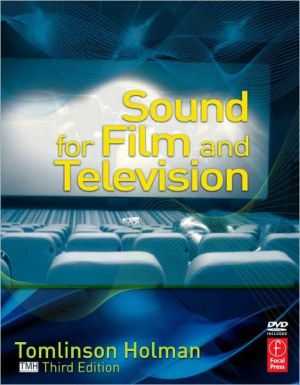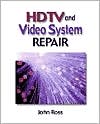Sound for Film and Television
Sound for Film and Television, Third Edition provides a thorough introduction to the fascinating field of recording, editing, mixing, and exhibiting film and television sound. It strikes a fine balance between aesthetic and technical content, combining theory and practice to approach sound as both an art and a science. This new edition has been completely updated to reflect the latest advances in HD technology, new hardware and software systems, new distribution methods, wireless sound...
Search in google:
THX sound guru Tomlinson Holman gives readers the latest on creating great sound for film & television!
Sound for Film and Television\ \ By Tomlinson Holman \ Focal Press\ Copyright © 2010 Tomlinson Holman\ All right reserved.\ ISBN: 978-0-08-051740-7 \ \ \ Chapter One\ Objective Sound\ AN OLD STORY\ A tree falls over in a wood. Does it make a sound? From one point of view, the answer is that it must make a sound, because the physical requirements for sound to exist have been met. An alternate view is that without any consciousness to "hear" the sound, there in fact is no sound. This dichotomy demonstrates the difference between this chapter and the next. A physicist has a ready answer—of course, there is a great crashing noise. On the other hand, a humanist philosopher thinks consciousness may well be required for there to be a sound.\ The dichotomy observed is that between objective physical sound and subjective psychoacoustics. Any sound undergoes two principal processes for us to "hear" it. First, it is generated and the objective world acts on it, and then that world is represented inside our minds by the processes of hearing and perception. This chapter concentrates on the first part of this process—the generation and propagation of physical sound—whereas Chapter 2 discusses how the physical sound is represented inside our heads.\ The reason the distinction between the objective and the subjective parts of sound perception is so important is that in finding cause and effect in sound, it is very important to know the likely source of a problem: Is there a real physical problem to be solved with a physical solution, or does the problem require an adjustment to accommodate human listening? Any given problem can have its roots in either domain and is often best solved in its own dominion. On the other hand, there are times when we can provide a psychoacoustical solution to what is actually an acoustical problem.\ An example of this is that often people think there is an equipment solution to what is, in fact, an acoustical problem. A high background noise level of a location cannot be solved with digital recording, for instance, although some people give so much credit to digital recording that they wonder whether this might not be true. "It's digital, so we won't need to do any postproduction, right?" has been asked naively of more than one sound mixer.\ PROPERTIES OF PHYSICAL SOUND\ There are several distinguishing characteristics of sound, partly arising from the nature of the source of the sound (is it big or small? does it radiate sound equally in all directions, or does it have a directional preference?) and partly from the prevailing conditions between the point of origin and the point of observation (is there any barrier or direct line of sight?). Sound propagates through a medium such as air at a specific speed and is acted on by the physical environment.\ Propagation\ Sound travels from one observation point to another by a means that is analogous to the way that waves ripple outward from where a stone has been dropped into a pond. Each molecule of the water interacts with the other molecules around it in a particular orderly way. A given volume of water receives energy from the direction of the source of the disturbance and passes it on to other water that is more distant from the source, causing a circular spreading of the wave. Unless the stone is large and the water splashes, the water molecules are disturbed only about their nominal positions, but eventually they occupy about the same position they had before the disturbance.\ Consider sound in air for a moment. It differs from other air movement, like wind or drafts, by the fact that, on the whole, the molecules in motion will return to practically the same position they had before the disturbance. Although sound is molecules in motion, there is no net motion of the air molecules, just a passing disturbance.\ Another way to look at how sound propagates from point to point is to visualize it as a disturbance at a dance. Let us say that we are looking down on a crowded dance floor. With contemporary dancing, there isn't much organization to the picture from above—the motion is random. A waiter, carrying a large tray, enters the dance floor. The dancers closest to the waiter have to move a lot to get out of his way, and when they then start to bump into their neighbors, the neighbors move away, etc. The disturbance may be very small by the time it reaches the other side of the dance floor, but the action of the waiter has disturbed the whole crowd, more or less. If the waiter were to step in, then out, of the crowd, people would first be compressed together and then be spread apart, perhaps farther than they ever had been while dancing. The waiter in effect leaves a vacuum behind, which people rush in to fill. The two components of the disturbance are called compression, when the crowd is forced together more closely than normal, and rarefaction, when the spacing between the people is more than it is normally.\ The tines of a tuning fork work like the waiter on the dance floor, only the dancers are replaced by the air molecules around the tuning fork. As the tines move away from the center of the fork, they compress the outside air molecules, and as they reverse direction and move toward one another, the air becomes rarefied (Fig. 1.3). Continuous, cyclical compression and rarefaction form the steady tone that is the recognized sound of a tuning fork.\ Our analogy to water ripples can be carried further. In a large, flat pond, the height of the waves gets smaller as we go farther from the origin, because the same amount of energy is spread out over a larger area. Sound is like this, too, only the process is three-dimensional, so that by spreading out over an expanding surface, like blowing up a balloon, the energy farther from the source is even less. The "law" or rule that describes the amplitude of the sound waves falling off with distance is called the inverse square law. This law states that when the distance to a sound source doubles, the size of the disturbance diminishes to one-quarter of its original size:\ Strength of sound at a distant point = original strength=distance:\ Track 4 of the DVD that accompanies this book illustrates the inverse square law effect of level versus distance.\ The inverse square law describes the fall-off of sound energy from a point source, radiating into free space. A point source is a source that is infinitesimal and shows no directional preference.\ In actual cases, most sources occupy some area and may show a directional preference, and most environments contain one or more reflecting surfaces, which conspire to make the real world more complex than this simple model.\ One of the main deviations from this model comes when a source is large, say, a newspaper press. Then it is difficult to get far enough away to consider this to be a point source, so the falloff with distance will typically be less than expected. This causes problems for narrative filmmakers trying to work in a press room, because not only is the press noisy, but the falloff of the noise with distance is small.\ Another example is an explosion occurring in a mine shaft. Within the shaft, sound will not fall off according to the inverse square law because the walls prevent the sound pressure from spreading. Therefore, even if the sound of the explosion is a great distance away, it can be nearly as loud as it is near its source, and quite dangerous to the documentary film crew members who think that they are sufficiently far away from the blast to avoid danger.\ The water analogy we used earlier falls apart when we get more specific. Ripples in water are perpendicular to the direction of propagation—that is, ripples in a pond are up and down. These are called transversal waves. Sound waves, on the other hand, are longitudinal; that is, they are in the direction of travel of the wave. Visualize a balloon blowing up with a constant rate of inflation equal to the speed of sound, while its surface is oscillating in and out, and you have a good view of sound propagation.\ A Medium Is Required\ Sound requires a medium. There is no medium in the vacuum of outer space, as Boyle discovered in 1660 by putting an alarm clock suspended by a string inside a well-sealed glass jar. When the air was pumped out of the jar to cause a vacuum and the alarm clock went off, there was no sound; but when air was let back in, sound was heard. This makes sense in light of our earlier discussion of propagation: If the waiter doesn't have anything to disturb on the dance floor, he can hardly propagate a disturbance.\ For physicists, the famous opening scene of Star Wars makes no sense, with the rumble from its spaceships arriving over one's head, first of the little ship and then the massive Star Destroyer. No doubt the rumble is effective, but it is certain that somewhere a physicist groaned about how little filmmakers understand about nature. Here is an example of where the limitations of physics must succumb to storytelling. Note that although radio signals and light also use wave principles for propagation, no medium is required: These electromagnetic waves travel through a vacuum unimpeded.\ Speed of Sound\ The speed of sound propagation is quite finite. Although it is far faster than the speed of waves in water caused by a stone dropping, it is still incredibly slower than the speed of light. You can easily observe the difference between light and sound speed in many daily activities. Watch someone hammer a nail or kick a soccer ball at a distance, and you can easily see and hear that the sound comes later than the light—reality is out of sync! Filmmakers deal with this problem all the time, often forcing into sync sounds that in reality would be late in time. This is another example of film reality being different from actual reality. Perhaps because of all of the training that we have received subliminally by watching thousands of hours of film and television, reality for viewers has been modified: Sound should be in hard sync with the picture, deliberately neglecting the effects of the speed of sound, unless a story point sets up in advance the disparity between the arrival times for light and sound.\ The speed of sound is dependent on the medium in which the sound occurs. Sound travels faster in denser media, and so it is faster in water than in air and faster in steel than in water. The black-hatted cowboy puts his ear to the rail to hear the train coming sooner than he can through the air, partly because of the faster speed of sound in the material and partly because the rail "contains" it, with only a little sound escaping to the air per unit of length.\ Sound travels 1130 ft/sec in air at room temperature. This is equal to about 47 ft of travel per frame of film at 24 frames per second. Unfortunately, viewers are very good at seeing whether the sound is in sync with the picture. Practically everyone is able to tell if the sync is off by two frames, and many viewers are able to notice when the sound is one frame out of sync!\ Because sound is so slow relative to light, it is conventional lab practice to pull up the sound on motion picture analog release prints one extra frame, printing the sound "early," and thus producing exact picture–sound sync 47 ft from the screen. (Picture and sound are also displaced on prints for other reasons; the one frame is added to the other requirements.) In very large houses, such as Radio City Music Hall or the Hollywood Bowl, it is common practice to pull up the sound even more, putting it into sync at the center of the space. Still, the sound is quite noticeably out of sync in many seats, being too early for the close seats and too late for the distant ones. Luckily, this problem is mostly noticeable today only in those few cases in which the auditoriums are much larger than the average theater. Because of the one-frame pull-up built into all prints, for a listener to be two frames out of sync, the listener would have to be three frames away from the screen, or about 150 ft. The Hollywood Bowl measures 400 ft from the stage to the back row, so the sync problems there are quite large and are made tolerable only by the small size of lips when seen from such a large distance (see Figure 1.5). The speed of sound is fairly strongly influenced by temperature (see speed of sound in the Glossary), so calculations of it yield different results in the morning compared to a warm afternoon, when the speed of sound is faster.\ Amplitude\ The "size" of a sound wave is known by many names: volume, level, amplitude, loudness, sound pressure, velocity, or intensity. In professional sound circles, this effect is usually given the name level. A director says to a mixer "turn up the level," not "turn up the volume," if he or she wants to be taken seriously.\ (Continues...)\ \ \ \ \ Excerpted from Sound for Film and Television by Tomlinson Holman Copyright © 2010 by Tomlinson Holman. Excerpted by permission of Focal Press. All rights reserved. No part of this excerpt may be reproduced or reprinted without permission in writing from the publisher.\ Excerpts are provided by Dial-A-Book Inc. solely for the personal use of visitors to this web site. \ \
Preface; Introduction; Objective Sound; Psychoacoustics; Audio Fundamentals; Microphones Technicalities; Handling the Output of Microphones; Production Sound Mixing; Sync, Sank, Sunk; Transfers; Sound Design; Editing; Mixing; Recording; Synchronization; From Print Masters to Exploitation; Transfers; Editing; Mixing; From Print Masters to Exhibition; Working with Decibels; Filmography; The Eleven Commandments of Film Sound; Bibliography; Glossary; Index; About the Author; Companion Website Page; Instructions for Accompanying DVD
\ From the Publisher"The best overall technical introduction to film sound...As one would expect from the developer of the THX Sound System, among many other achievements, this book has a comprehensive approach and features one of the best introductions to psychoacoustics that you'll read anywhere."--Larry Blake, Mix Magazine\ "The book provides a fascinating and incredibly informative introduction to the world of film and television sound and is well recommended."--James Eade, Lighting and Sound International\ "Holman covers a lot of ground in just over 250 pages. His knowledge of the subject and many of the major industry players is evident. Sound for Film and Television is a concise, informative, entertaining, and intimate review that can serve as an introduction to the subject for the student and a snapshot of current techniques and processes for the practitioner."--The Journal of the Audio Engineering Society\ \ \








